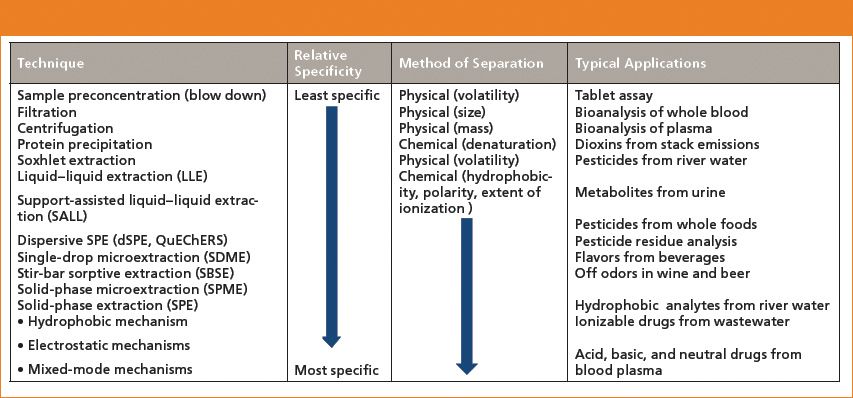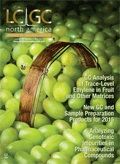Choosing the Correct Sample Preparation Technique
LCGC North America
All sample preparation adds the potential for error to the analytical protocol, so choosing less-complicated techniques will help to reduce inherent error.
There are many reasons for choosing to implement sample preparation, but most fall under the three general aims shown in Table I.

In many cases the type of sample preparation used will depend on the analyte type, the sample matrix, or the instrument technique that will be used for the analysis. In other words, various industries and applications are suited to certain types of sample preparation - some of these have been outlined in Figure 1, alongside the relative specificity of some common sample preparation techniques.

Figure 1: Description of the various commonly used sample preparation techniques. Note that the list of typical applications is for illustrative purposes only and is not meant to be exhaustive.
All sample preparation adds the potential for error to the analytical protocol, so choosing less-complicated techniques will help to reduce inherent error. The use of preconcentration with an inert gas stream for volatile samples or extracts can add significant error to the method.
Knowing the target analyte concentration will help to inform the correct choice of sample preparation technique. The attainable limit of detection (LOD) or limit of quantitation (LOQ) will be directly related to the specificity of the sample preparation technique. It is this parameter that needs to be optimized, as far as is possible, to achieve the cleanest extracts and the lowest limits of detection.
Specificity in sample preparation is optimized when any differences in the chemistry or physicochemical properties of the analyte molecules and the sample matrix are exploited. Strategic ways in which selectivity might be optimized include
- Adjusting aqueous sample pH to ensure ionizable analytes are ion-suppressed (nonionized) and will partition more efficiently into the organic phase in liquid–liquid extraction (LLE).
- Increasing the salt concentration of the aqueous phase to drive polar analytes into the organic phase during LLE.
- Using prebuffered supports in support assisted LLE to ensure ionizable analytes are preferentially retained either within the organic or aqueous solvent systems (ionized form in the aqueous sample initially applied or nonionized in the organic extraction solvent).
- Optimize the salt concentration and sorbent type to remove as much of the sample matrix as possible while leaving target analytes behind in dispersive solid-phase extraction (SPE).
- Use the most selective sorbent in SPE based on the chemistry of the analytes, and include an electrostatic element to the retention mechanism wherever possible to optimize the strength of retention and therefore specificity. Use the strongest wash solvent and weakest elution solvent strength (this can be in terms of the organic:aqueous solvent ratio, pH or buffer ion type, or concentration) to optimize the selectivity of the process.
- For stir-bar sorptive extraction (SBSE), solid-phase microextraction (SPME), and single drop microextraction (SDME), choose the surface chemistry carefully to be as closely matched to the analyte of interest as possible and optimize factors such as pH, temperature, and headspace versus immersed sampling to improve the specificity of the extraction.
For more information on applications and considerations such as extraction method capacity and practical implementation see the CHROMacademy tutorial.


.png&w=3840&q=75)

.png&w=3840&q=75)



.png&w=3840&q=75)



.png&w=3840&q=75)








